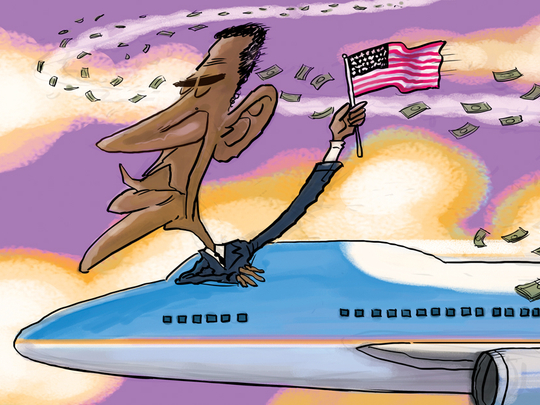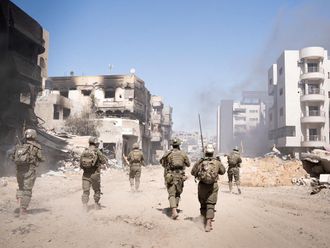
President Barack Obama’s current trip to India entails all the pomp and circumstance that generally accompanies the president of the United States abroad. During the visit, he is expected to celebrate India’s Republic Day today as a guest of Prime Minister Narendra Modi. Such trips are complicated undertakings that require months of planning and immense coordination and communication. With all the public ceremony and behind-the-scenes manoeuvring, it’s easy to understand how myths evolve. Let’s dispense with some.
Host countries welcome the attention that comes with a visit by the US president
Most countries, even America’s geopolitical rivals, do want the US president to visit. Having the leader of the most powerful country in the world come to you always conveys respect. And it can bestow legitimacy on an emerging government, such as the one in Myanmar, where Obama went in November.
Yet there’s often a fear of negative attention and meddling. The US president is notorious for making speeches on themes such as democracy or free speech in countries where such values are not always held dear. And so, during Obama’s 2009 trip to China, Chinese officials detained dissidents and blocked broadcast of Obama’s town-hall meeting with students in Shanghai — a meeting that White House aides had hoped would go some way towards encouraging the opening of Chinese society.
Similarly, Steve Atkiss, who served as special assistant for operations to president George W. Bush, recalls a presidential trip to Russia when many civil-society activists did not show up for a planned event at the US Embassy in Moscow.
“They were told it would be a bad idea,” he says.
A visit by the president necessitates that cities go into lockdown
When the US president is coming, local media outlets love to write about how their cities will be brought to a standstill. Obama’s India trip is no exception. The Hindustan Times reported: “The capital is set to witness a lockdown of sorts in the run-up to January 26, with offices, arterial roads and Metro stations closed for security.”
It’s true that presidential trips require extraordinary security and some disruption. But “there are plenty of times where the [host] governments go way overboard,” Atkiss says. He recalls arriving in New Delhi with Bush in 2006: The main boulevards were virtually empty, with no evidence of the lively street culture — the crowds of people, the occasional cow — that usually predominates. “We had to look a couple hundred yards down side streets to see any people,” he says.
For Obama’s visit to New Delhi, his entourage has booked the entire Maurya hotel. On other trips, however, fellow hotel guests have been free to go about their business once they’ve gone through metal detectors.
They may even catch the president doing a few reps in the gym. Last June, Obama’s workout was surreptitiously captured on video at his hotel in Poland. The Secret Service dismissed talk of any security breach. “This is no different than if the president visited a restaurant off the record and other diners took pictures of him,” Secret Service spokesman Brian Leary said at the time.
The president is at greater risk on foreign trips
Of course, during any high-profile trip, the president may be a high-profile target. That’s why the Secret Service has been pressing the Indian government to make an exception to tradition and allow Obama to ride in his own bulletproof limousine to the Republic Day parade rather than accompanying the Indian president.
The Secret Service must rely on foreign security forces to augment its own when it travels abroad with the president — and that system is not fail-safe. During Bush’s 2005 trip to Tbilisi, Georgia, someone threw a grenade within 100 feet of the president while he was speaking on a podium to a throng of tens of thousands. (The grenade failed to detonate.)
That said, the Secret Service’s “away game” is intricately planned, and security officials are on heightened alert. Some Secret Service personnel believe that organised terrorist groups are more likely to focus on the vulnerabilities of the president’s routine travels, when security officials may let down their guard.
One former US official said it was often more difficult to work with law enforcement agencies in big American cities, such as New York, that are used to presidential visits and often pooh-pooh special requests from Washington.
The official recalled extra precautions taken abroad — such as on a Bush trip to Pakistan, when US security officials employed four different modes of transportation, including motorcades and helicopters, at each stop, so that even Pakistani security officials did not know which the president was travelling in and which were decoys.
Air Force One refuels in flight on long trips
“I’ve been reading through your press kit — I understand Air Force One is able to refuel in mid-air; well, we need fuel, until we get it down,” a hijacker demands in the Harrison Ford movie Air Force One.
The retrofitted Boeing 747 that usually serves as the presidential jet can indeed refuel in flight — but it has never done so with the president on board, military officials say.
It has enough range to fly from Washington to Iraq without needing more fuel. On longer trips to Asia, it typically stops at US military bases in Alaska or Germany.
However, an in-flight refuel is seen as safe enough that the defence secretary’s E-4B plane routinely refuels that way. The practice is so pro forma that journalists are invited to watch the procedure from the cockpit.
Air Force planes used by the vice president and Cabinet secretaries are not capable of in-flight refuelling, officials say.
Presidential travel abroad costs as much as the Afghan war
The last time Obama went to India, in 2010, his critics quickly picked up on rumours in the Indian press that the trip cost $200 million (Dh734.6 million) per day. Then-Congresswoman Michele Bachmann (Republican) and conservative talk-radio personalities Rush Limbaugh and Glenn Beck repeated the figure to blast the White House. At the time, the United States was spending about $190 million a day on its military and diplomatic campaign in Afghanistan.
Presidential travel is costly — but nowhere near that expensive. It’s difficult to know for certain, because the data is considered confidential, but a Secret Service internal memo leaked to the Washington Post ahead of Obama’s three-nation Africa tour in 2013 showed just how pricey long foreign trips can be.
As Washington Post reported, the trip entailed hundreds of Secret Service agents to secure facilities in Senegal, South Africa and Tanzania; a Navy aircraft carrier or amphibious ship, with a fully staffed medical trauma centre, stationed offshore in case of an emergency; and military cargo planes to bring in 56 support vehicles, including 14 limousines and three trucks loaded with sheets of bulletproof glass to cover the windows of the hotels where the first family stayed.
Fighter jets were to fly in shifts, giving 24-hour coverage over the president’s airspace.
People familiar with the planning estimated the costs as between $60 million and $100 million in all for the eight days Obama was away from Washington.
A report from the Government Accountability Office found that President Bill Clinton’s 1998 trip to six African nations cost the US government at least $42.7 million.
— Washington Post










